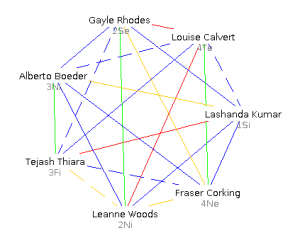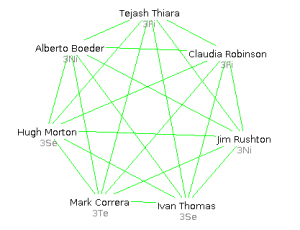Social Profiles
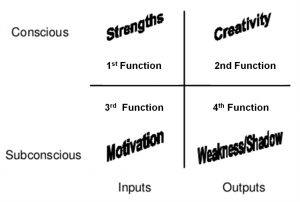 Social Profiles contain both a summary of an individual’s overall behaviour and his/her underlying strengths, potential weaknesses, degree of creativity, and sources of motivation.
Social Profiles contain both a summary of an individual’s overall behaviour and his/her underlying strengths, potential weaknesses, degree of creativity, and sources of motivation.
Unlike other behavioural assessments that identify an individual’s preferences or traits, 4G evaluates the way in which people make sense of the world around them i.e., how individuals “Process Information”.
How individuals process the information they receive, as well contextualize and abstract their experiences determines which of the 16 different 4G Social Profiles applies to them.
Summary 4G Social Profiles
| Social Profiles in Social Group 1 | Social Profiles in Social Group 2 | Social Profiles in Social Group 3 | Social Profiles in Social Group 4 |
|---|---|---|---|
| 1Fe 1Fe’s are naturally enthusiastic and energetic Have strong communication skills and enjoy prolonged social interaction Will seek assurances that they he/she has been properly understood Places considerable value on those who help and assist them It is important for your colleague to feel at the centre of the action It is important for your colleague to work in a manner that lets them be creative May have difficulties embracing change or dealing with ambiguity | 2Fe 2Fe’s are people-focused, far-sighted and compassionate Possess strong communication skills and are able to hold an audience Are principled and ethical in his/her approach to work Persuasive, charismatic and able to convince others of his/her point of view Work needs to be consistent with his/her long-term values and goals Are able to identify opportunities and potential in new ideas Can neglect or ignore immediate issues or problems | 3Fi 3Fi’s are friendly, helpful individuals, who will ensure their responsibilities are met Are able to find problems and difficulties in proposals Often go out of their way to ensure the wellbeing of others Like to plan and prepare and have excellent organizational skills Are resilient and determined when facing obstacles or challenges Dislikes uncertainty or situations that are unclear or unfamiliar Benefits from an environment where people are calm and polite | 4Fi 4Fi’s are excellent at helping and assisting other people Are diplomatic, ethical and considered in his/her approach to work Maintains high standards and has good attention to detail Benefits from being given freedom or autonomy to develop his/her work Appreciates clear planning and a measured approach to work Are regarded as consistent and reliable by others May not be forceful or direct enough when facing obstacles |
| 1Ne 1Ne’s are idea generators and often propose radical and innovative solutions Enjoy developing specific expertise and understanding Are able to shed fresh light on existing problems Sees the hidden potential in people and new ideas Prefers a working environment that is unpredictable and varied Maintaining energy and focus can also be difficult May struggle with organization and performing routine tasks | 2Ni 2Ni’s are imaginative and naturally drawn towards new products or services Are forward looking and able to understand potential and risk in most situations Can raise morale and paint a positive picture of the future Strong communication skills and can easily empathize with others Encourages an informal and tension free atmosphere May be impetuous or not stick to the plan or suggested course of action Can sometimes struggle to focus on details or routine tasks | 3Ni 3Ni’s are imaginative and enjoy challenging conventional thinking Enjoys taking a contrary approach and debating ideas Are drawn towards propositions that offer large, significant returns Are adept at identifying commercial potential in new opportunities Economical and prudent with financial matters May not always consider the impact of his/her decisions on others Can neglect routine or mundane tasks | 4Ne 4Ne’s have excellent people skills and can handle awkward situations easily Displays optimism for his/her work and can transfer this easily to others Will defend and promote any groups that he/she is a member of Are quick and nimble in their responses to external activity Thrives on adventure, spontaneity and originality Enjoys wide ranging speculative discussions May need to put effort into organization, planning and attention to detail |
| 1Si 1Si’s value transparency and openness in the workplace Your colleague is low-key and consensual in his/her approach to work Enjoys sharing and disseminating new and relevant information Has a strong sense of visual or presentation issues Excellent at diplomacy and maintaining a neutral position Takes a balanced and informal approach to work Is able to maintain good relationships over long periods | 2Se 2Se’s are determined, resilient and sometimes impatient Are able to work quickly and efficiently Can quickly build up solid expertise in a particular area Rarely ruffled and can display high levels of self control under pressure Are adept at overcoming obstacles to progress Will be able to focus on commercial or other measurable outcomes Can be insensitive or rash in his/her decision-making | 3Se 3Se’s are strong personalities who enjoy being in positions of responsibility Encourages other people to show positive emotions Excellent motivators and passionate people Very determined and resilient in the face of obstacles Ensures that the end goal is realistic and attainable prior to starting work Seeks rapid returns and often search out direct challenges May struggle to see beyond short-term issues | 4Si 4Si’s are focused around practical and economic returns from his/her work Are able to extract the maximum value from situations Works at his/her best when given a free hand and independence Enjoy being in positions of responsibility and not afraid to make difficult decisions Place significant value on interpersonal relationships and requires positive feedback Has an eye for detail, design and presentation Can be abrupt and fail to read the signals from others |
| 1Ti 1Ti’s are analytical, experimental and enjoy developing his/her expertise Your colleague enjoys situations when given freedom and few constraints Are able to hold their interest for extended periods, refining and developing ideas Your colleague is meritocratic in outlook and dislikes excessive bureaucracy or strict hierarchy Encourages idea sharing and the application of people’s talents Is drawn towards situations requiring an alternative or innovative approach May not place much emphasis on presentation and design | 2Ti 2Ti’s are factually orientated and pay close attention to detail Relies on proven methods, techniques and approaches to problem solving Enjoys sharing knowledge and expertise with others Enjoys being in situations where complex obstacles or problems need to be overcome Strong organizational and administrative abilities Will work in a precise and controlled manner Dislikes situations that are uncertain or where logic and analysis can be deployed | 3Te 3Te’s are drawn to commercial issues; in particular ideas promising large returns Will spend time researching and exploring the practicality of new ideas Enjoys being in power and offering advice and recommendations to others Are able to work quickly and can often multi-task successfully Are optimistic and positive about long-term opportunities Can quickly over-extend his/herself or themselves too thinly Can be autocratic or insensitive to the needs of others | 4Te 4Te’s are adept at handling large amounts of data and analytical information Work quickly and efficiently, especially when under pressure Approaches goals and targets in a determined and direct manner Values transparency, consistency and competence in others Has an eye for detail and presentation Will look to bring order and stability and consistency to his/her working environment May struggle with situations that are ambiguous or uncertain |
Social Relationships
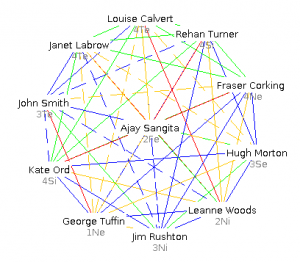
Once two individual's Social Profiles are known, 4G can predict the nature and type of relationships that will develop.
Knowing how individuals process information and their experiences, 4G can forecast the nature or ease of their interactions with others, and, therefore, determine their specific “Social Relationship.”
There are 14 different Social Relationships.
The order of the relationships on the right provides a framework to determine which Social Relationship is more productive than another. This order is also used to calculate Relationship Friction.
Social Relationships also enable us to derive Social Groups, early adopters, cross organizational cohesion and areas for development.
Social Relationships and Colours
As can be seen in the diagram, Social Relationships are shown using different colours. The colours are defined as follows:
- Green: Little or no effort is needed in order to make the relationship productive. The best and most productive relationships.
- Blue: Some effort is needed to make the relationship productive when compared to green relationships but overall, a largely positive relationship.
- Yellow: Significant effort is needed to make the relationship productive.
- Red: Substantial effort is needed to make the relationship productive.
Summary 4G Social Relationships
The following summaries introduce each of the 14 Social Relationships via a one line overview. Further detail, metaphors, coaching tips and recommendations on how to improve specific relationships are outlined in the Visual Team Builder and in the reports available from 4G.
- Action: Immediate common energy and motivation
- Pairs: Identical working style and perceptions
- Balance: Complimentary strengths and weaknesses
- Reflection: Critical mutual feedback readily accepted
- Association: Easy agreement on goals, but can differ on approach to tactics
- Comfort: Work inefficiencies obscured by surface warmth of relationship
- Semi-Balance: Differences beneath the surface emerge from time to time
- Similarity: Apparent differences are overcome with interaction
- O-r-d-e-r: Inherently hierarchical, can be efficient or contentious
- Contrast: Work best one-on-one, but cooperation breaks down with the broader group
- Focus: Struggle to move big ideas to meaningful tactical outcomes
- A-s-s-i-s-t-a-n-c-e: Suggestions offered by more junior relationship partner may or may not be readily accepted
- Interpretation: Apparent agreement hard to reach -- quickly evaporates under scrutiny
- Discovery: Expect easy collaboration and frequently surprised by friction and irritation
Social Groups
 Social Groups define group values or cultures that are found between Social Profiles who share the same number. For example, a team comprising of a 1Fe, 1Si and 1Ti would all be from Social Group 1, whilst a team of people whose profiles were 3Ni, 3Se and 3Te would be from Social Group 3.
Social Groups define group values or cultures that are found between Social Profiles who share the same number. For example, a team comprising of a 1Fe, 1Si and 1Ti would all be from Social Group 1, whilst a team of people whose profiles were 3Ni, 3Se and 3Te would be from Social Group 3.
When individuals are part of the same Social Group, they come together to share common group values, enabling the group to work together more cohesively. By extension, performance is likely to be above average.
4G also identifies which value system the Social Group will have an affinity with in terms of values, working environment, group pioneers and early adopters.
Social Group Proxies
As a point of reference, the ideas behind Social Groups can be seen in other approaches and theories. The first is the idea of a product life cycle consisting of innovation, early adopters, mass market and late adopters. Each of these four stages are analogous to the four Social Groups detailed below.
The second approach is the Cynefin model which outlines a four domain theory for sense-making consisting of Chaos, Complex, Complicated and Simple (a fifth domain or vacuum also features). This also offers a good degree of analogy or representation when considering metaphors and alternative definitions for the Social Groups.
Social Group Summaries
The table below introduces summary definitions of each of the four Social Groups.
| Social Group | Social Profiles | Values | Optimal Working Environment | Pioneers (p) and Early Adopters (a) |
|---|---|---|---|---|
| Social Group 1 | 1Fe 1Ne 1Si 1Ti | Adaptive Flux Revolution Over Evolution | Innovative Novel | 1Ne (p) 1Ti (a) |
| Social Group 2 | 2Fe 2Ni 2Se 2Ti | Competitive Egalitarian Pluralistic | Early Adopter Emergent | 2Fe (a) 2Ni (p) |
| Social Group 3 | 3Fi 3Ni 3Se 3Te | Cause and Effect Control Replication | Mass Market Good Practice | 3Ni (p) 3Te (a) |
| Social Group 4 | 4Fi 4Ne 4Si 4Te | Structure Stability Perfection | Value Maximiser Best Practice | 4Fi (a) 4Ne (p) |
The Visual Team Builder
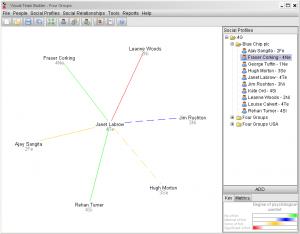 The Visual Team Builder (VTB) software is one of the key components of 4G and allows users to visualise and quickly access information relating to individuals, relationships and teams. The VTB also enables users to quickly generate 4G reports and utilise a number of other 4G features.
The Visual Team Builder (VTB) software is one of the key components of 4G and allows users to visualise and quickly access information relating to individuals, relationships and teams. The VTB also enables users to quickly generate 4G reports and utilise a number of other 4G features.
There are a number of features in the Visual Team Builder that add significantly to the value of 4G. In particular the VTB enables users to gain an accelerated understanding or insight into any particular team. It also makes 4G a much more scalable instrument, offering the ability to quickly model or understand specific relationship and team dynamics across an entire organisation.
Visual Team Builder Features
The VTB enables:
- The prediction and analysis of relationships and group dynamics between employees
- The modelling and prediction of teams whether recruiting, improving team performance or enhancing business processes
- The modelling of different scenarios prior to implementation in order to evaluate potential increases in performance and ROI
- The use of developmental and coaching recommendations for individuals and teams
Visual Team Builder Demo
Relationship Friction
Relationship Friction is a formula linking people’s behaviour and relationships to measures of financial performance.
Different Social Relationships require different levels of time, effort and energy in order to function at their best. By comparing the level of effort in a particular Social Relationship with both people's salaries, it is possible to show how much money is spent on Relationship Friction1. In turn, this allows the cost of relationships to be quantified in financial terms and linked to measures of performance such as metrics, revenues or costs.
An Example of Relationship Friction
In the table below, a random team of 7 is analysed using Relationship Friction2, 3. Everyone in the team is paid £50,000, making the total salary for the team £350,000. Given the 7 Social Profiles and the breakdown of the 21 Social Relationships, the cost of Relationship Friction for this team is £60,195 or 17.2% of the total team salary. In addition, the Relationship Friction Index is 864, allowing Relationship Friction data to be compared across different teams without revealing sensitive salary information.
| Name | Social Profile | Salary |
|---|---|---|
| Alberto Boeder | 3Ni | £50,000 |
| Fraser Corking | 4Ne | £50,000 |
| Gayle Rhodes | 2Se | £50,000 |
| Lashanda Kumar | 1Si | £50,000 |
| Leanne Woods | 2Ni | £50,000 |
| Louise Calvert | 4Te | £50,000 |
| Tejash Thiara | 3Fi | £50,000 |
| Total Salaries | £350,000 | |
| Relationship Friction | £60,195 | |
| Relationship Friction % | 17.2% | |
| Relationship Friction Index | 864 |
The table below shows the change in Relationship Friction if the team of 7 is optimised around a particular Social Group, in this case, Social Group 3. By creating a team in which everyone is a member of the same Social Group, not only does everyone experience optimal Social Relationships, but the Relationship Friction figures improve dramatically.
Relationship Friction falls to £18,357 or 5.2% of the team's combined salary. This is a difference in Relationship Friction of £41,838, or a fall of 12%. Likewise, the Relationship Friction index falls to 264.
| Name | Social Profile | Salary |
|---|---|---|
| Alberto Boeder | 3Ni | £50,000 |
| Claudia Robinson | 3Fi | £50,000 |
| Hugh Morton | 3Se | £50,000 |
| Ivan Thomas | 3Se | £50,000 |
| Jim Rushton | 3Ni | £50,000 |
| Mark Correra | 3Te | £50,000 |
| Tejash Thiara | 3Fi | £50,000 |
| Total Salaries | £350,000 | |
| Relationship Friction | £18,357 | |
| Relationship Friction % | 5.2% | |
| Relationship Friction Index | 264 |
Relationship Friction makes it possible to create more financially and operationally efficient environments for teams and individuals. In the case of teams, it is possible to manage team composition, reporting lines and overall organisational design against the backdrop of Relationship Friction and financial performance. From an individual perspective, lower Relationship Friction figures equate to higher levels of performance, engagement and well-being.
The data behind 4G and Relationship Friction has been empirically tested and is valid. For more information on the research behind 4G and Relationship Friction, please request a copy of the test manual.
Footnotes
1. While Relationship Friction calculations are typically expressed as costs, it should be noted that these costs are not quantifiable in the manner that an accountant would formally recognise. That said, Relationship Friction does offer a way to quantify the previously intangible which can then be analysed alongside other quantifiable measures.
2. To create the random team, a spreadsheet was used to simulate different combinations of Social Profiles. By way of context, having run the random team generator over 50 times, the average Relationship Friction % is calculated at 16.3% with a low of 12.3% and a high of 19.2%.
3. Work to date suggests that overall, teams typically have an average or normal distribution of Social Profiles and Social Relationships within them. There are some functional and industry biases (e.g. HR typically has more feeling profiles i.e. those with F in their acronym) but for the sake of this example, the random team presented is a good representation of what might be found if a team was picked at random from any organisation, regardless of seniority or function.
Coaching Modules
There are 16 4G Coaching Modules. Each module is written in two parts. The first half contains the core concepts, while the second is custom written to reflect the different approaches adopted by people based on their Social Profile.
As a result of this personalisation, all of the coaching modules are customised to suit each person’s perspective on the topic, in turn creating an individual and bespoke approach to training and development.
The table below provides an overview of each of the 16 4G Coaching Modules.
| Name | Description | Uses | Related Modules |
|---|---|---|---|
| Careers Guidance | Introduces ideas around career development strengths creativity and different types of role and organisation amongst others. | For people seeking a change in their career or who are making decisions about the ongoing direction of their working life. | Dealing with Change Leadership Negotiation The First 100 Days |
| Coaching and Mentoring | Contains a theoretical overview of the approaches and benefits of coaching in the workplace. This module provides an overall guide to how to coach and mentor each of the 16 Social Profiles. | Aimed at coaches and managers, the information allows the facilitator to accelerate the coaching process towards enabling more meaningful discussion. | Communication, Praise and Feedback Interviewing |
| Communication Praise and Feedback | A single document which provides a framework on how to optimise communication with each of the 16 Social Profiles. | Used by managers or anyone who regularly has to provide feedback or motivate and enthuse those around them. | Leadership Conflict Management Emotional Intelligence The Art of Delegation |
| Conflict Management | This module explores the benefits as well as negative impact of conflict in the workplace. Each module examines the individual?s likely reaction to conflict and how to improve this aspect of their work. | Situations where an individual has to manage conflict, or encourage a degree of conflict to boost productivity and performance. | Communication Praise and Feedback Negotiation The Art of Delegation |
| Creativity and Problem Solving | Examines each of the 16 Social Profile?s approach to creativity and problem solving. Each module looks at what motivates and stimulates individuals and how to encourage this aspect of their behaviour. | Coaches and managers who are looking to motivate and enthuse their people, help them identify types of work which will be stimulating and rewarding. Situations where a more creative approach to work is required. | Dealing with Change Leadership Emotional Intelligence Self-Motivation and Stress |
| Dealing with Change | Contains a theoretical overview of current thinking on organisational change. Each module examines the strengths and weaknesses of attitudes towards change. It contains strategies and insights on how each Social Profile can become more receptive towards change. | For individuals who are having to deal with change within the workplace, people who are having difficulty adjusting to change. | Conflict Management Creativity and Problem Solving The First 100 Days |
| Emotional Intelligence | An overview of Emotional Intelligence and how it relates to 4G. | Organisations already using EI. Alternatively as a general discussion document aimed at improving self-awareness and self-development. | Communication, Praise and Feedback Creativity and Problem Solving Leadership Self Development |
| Interviewing | A document which provides an interviewing strategy for each of the 16 Social Profiles. Each module deals with topics and areas of discussion which are designed to make the candidate feel comfortable and then move the discussion on to various aspects of work which are designed to stretch the candidate a little more. | For managers or recruiters undertaking interviews. This module is designed to allow the interview to view each of the candidates in a neutral and objective manner. | Coaching and Mentoring Communication, Praise and Feedback The First 100 Days |
| Leadership | This module summarises some theoretical approaches to leadership as well as looking at each of the 16 Social Profiles? natural strengths and weaknesses when it comes to leadership. | This module is oriented towards coaches and managers who are working with business leaders and those who are gaining increased responsibility and control over people. | Communication, Praise and Feedback Creativity and Problem Solving Strategy and Organisational Culture The First 100 Days |
| Negotiation | Provides a theoretical overview of negotiation strategy and practice. Each of the modules provides a description of the natural attitude and negotiation style of each of the 16 Social Profiles. This module also includes some exercises. | Ideal for managers or individuals who are looking to improve their own understanding of negotiation and also understand how others view the process. | Conflict Management Leadership Strategy and Organisational Culture |
| Self Development | This module deals with elements of self-awareness and understanding looking at areas of natural strengths and weakness. It also looks at areas of work to avoid or those that are likely to cause stress. | Coaches or managers looking to provide an overall plan or model for self-development. It may also be useful for re-engaging people who are ‘stuck in a rut’ and need new impetus. | Communication, Praise and Feedback Creativity and Problem Solving Dealing with Change Emotional Intelligence Self Motivation and Stress |
| Self Motivation and Stress | 4G points towards the thin line between being motivated and enthusiastic and stress and the loss of focus. This module provides a framework for all 16 Social Profiles to identify what motivates them. | Coaches and managers looking to improve the productivity job-satisfaction of their coachees. | Creativity and Problem Solving Leadership Self Development Time Management |
| Strategy and Organisational Culture | Looks at how an individual?s personality can impact on the general strategy or culture of an organisation. | For coaches working with senior managers or business leaders who want to understand their own impact on the business and how they can achieve a more objective overview of organisational strategy. | The Art of Delegation Leadership Negotiation |
| The Art of Delegation | This module looks at how each of the 16 Social Profiles approach delegation and provides hints and tips on how to handle this aspect of work. | Coaches and managers looking to help their clients improve their effectiveness and judgement when it comes to delegating. | Self Development Leadership Time Management |
| The First 100 Days | This module contains information on how to handle the transition to a new job or organisation. | This is for coaches who have clients who are moving or have recently moved to a new job. This module is best suited towards managers and those who are likely to have to manage new colleagues. | Interviewing Leadership Strategy and Organisational Culture |
| Time Management | Explores various aspects of time management and looks at blockages and impediments. Each module deals with the likely distractions and issues which can affect each of the 16 Social Profiles. | Coaches and managers who are looking to improve on the efficiency and time management of their clients. | Self Motivation and Stress The Art of Delegation |





